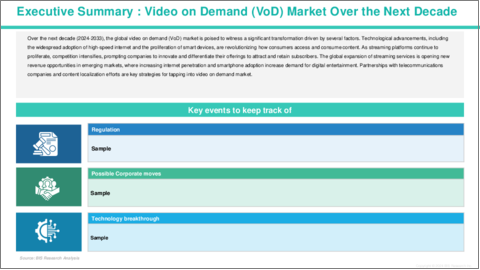|
|
市場調査レポート
商品コード
1485697
ビデオオンデマンド(VoD)の世界市場:用途別、コンテンツタイプ別、収益モデル別、ライセンシングタイプ別、地域別 - 分析と予測(2024年~2034年)Global Video on Demand (VoD) Market: Focus on Application, Content Type, Revenue Model, Licensing Type, and Region - Analysis and Forecast, 2024-2034 |
||||||
カスタマイズ可能
|
|||||||
| ビデオオンデマンド(VoD)の世界市場:用途別、コンテンツタイプ別、収益モデル別、ライセンシングタイプ別、地域別 - 分析と予測(2024年~2034年) |
|
出版日: 2024年05月29日
発行: BIS Research
ページ情報: 英文 100 Pages
納期: 1~5営業日
|
全表示
- 概要
- 目次
世界のビデオオンデマンド(VoD)の市場規模は、いくつかの重要な要因や市場促進要因に後押しされ、力強い成長を遂げています。
楽観的シナリオを考慮すると、2024年の市場規模は1,754億米ドルになるとみられ、今後は11.67%のCAGRで拡大し、2034年には5,289億米ドルに達すると予測されています。この成長の主なきっかけは、便利でパーソナライズされたエンターテインメント体験に対する需要の高まりです。ビデオオンデマンドプラットフォームは、膨大なコンテンツライブラリーとシームレスなストリーミングサービスを提供し、消費者の進化する嗜好に応えることで重要な役割を果たしています。
| 主要市場統計 | |
|---|---|
| 予測期間 | 2024年~2034年 |
| 2024年の評価額 | 1,754億米ドル |
| 2034年予測 | 5,289億米ドル |
| CAGR | 11.67% |
ビデオオンデマンド(VoD)世界市場の重要な促進要因となっているのは、業界を超えたビデオコンテンツに対する需要の高まりです。エンターテインメント、教育、ヘルスケア、マーケティング、企業部門など、さまざまな業界で、視聴者を惹きつけ、メッセージを効果的に伝え、ビジネス目標を推進する上で、動画が威力を発揮することが認識されつつあります。この動向は、従来のテキストベースや静的なメディアに比べ、動画がより魅力的で記憶に残り、共有しやすいと感じる消費者の間で、ビジュアルコンテンツへの嗜好が高まっていることに後押しされています。オンデマンドビデオコンテンツの需要が急増し続ける中、ビデオオンデマンドプロバイダーは、提供するコンテンツの質とバラエティの強化、オリジナルコンテンツの制作への投資、コンテンツの推薦やパーソナライゼーションのための人工知能や機械学習などの先進技術の活用に注力しています。さらに、高速インターネット接続の普及、スマートフォンやスマートテレビの普及が、ビデオオンデマンド市場の拡大をさらに後押ししています。
当レポートでは、世界のビデオオンデマンド(VoD)市場について調査し、市場の概要とともに、用途別、コンテンツタイプ別、収益モデル別、ライセンシングタイプ別、地域別の動向、および市場に参入する企業のプロファイルなどを提供しています。
目次
エグゼクティブサマリー
第1章 市場:業界の見通し
- 動向:現在および将来の影響評価
- オリジナルコンテンツ制作の拡大
- ハイブリッドビジネスモデルへの移行
- サプライチェーンの概要
- バリューチェーン分析
- マーケットマップ
- 価格予測
- R&Dレビュー
- 規制状況
- ステークホルダー分析
- 主要な世界的イベントの影響分析
- 市場力学の概要
- 市場促進要因
- 市場抑制要因
- 市場機会
第2章 世界のビデオオンデマンド(VoD)市場、用途別
- 用途のセグメンテーション
- 用途の概要
- 世界のビデオオンデマンド(VoD)市場、用途別
- 世界のビデオオンデマンド(VoD)市場、コンテンツタイプ別
第3章 世界のビデオオンデマンド(VoD)市場、製品別
- 製品セグメンテーション
- 製品概要
- 世界のビデオオンデマンド(VoD)市場、収益モデル別
- 世界のビデオオンデマンド(VoD)市場、ライセンシングタイプ別
第4章 世界のビデオオンデマンド(VoD)市場、地域別
- 世界のビデオオンデマンド(VoD)市場- 地域別
- 北米
- 欧州
- アジア太平洋
- その他の地域
第5章 企業プロファイル
- 今後の見通し
- 地理的評価
- Netflix, Inc.
- Amazon.com, Inc.
- Google LLC
- Hulu LLC
- AT&T, Inc.
- Apple, Inc.
- Facebook, Inc.
- Warner Bros. Discovery, Inc.
- Fox Media LLC.
- Verizon Communications, Inc.
- Telefonaktiebolaget LM Ericsson
- Comcast Corporation
- Home Box Office, Inc.
- PARAMOUNT PICTURES
第6章 調査手法
Introduction to the Global Video-on-demand (VoD) Market
The global video-on-demand (VoD) market is experiencing robust growth, propelled by several key factors and market drivers. Considering the optimistic scenario, the market is expected to be valued at $175.4 billion in 2024 and is projected to grow at a CAGR of 11.67% to reach $528.9 billion by 2034. A primary catalyst for this growth is the increasing demand for convenient and personalized entertainment experiences. Video-on-demand platforms play a crucial role by offering a vast library of content and seamless streaming services, catering to the evolving preferences of consumers.
| KEY MARKET STATISTICS | |
|---|---|
| Forecast Period | 2024 - 2034 |
| 2024 Evaluation | $175.4 Billion |
| 2034 Forecast | $528.9 Billion |
| CAGR | 11.67% |
The increasing demand for video content across industries serves as a significant driver for the global video-on-demand (VoD) market. Industries across the spectrum, including entertainment, education, healthcare, marketing, and corporate sectors, are recognizing the power of video in engaging audiences, conveying messages effectively, and driving business objectives. This trend is fueled by the growing preference for visual content among consumers, who find videos more engaging, memorable, and shareable compared to traditional text-based or static media. As the demand for on-demand video content continues to surge, video-on-demand providers are focusing on enhancing the quality and variety of their offerings, investing in original content production, and leveraging advanced technologies such as artificial intelligence and machine learning for content recommendation and personalization. Additionally, the proliferation of high-speed internet connectivity and the widespread adoption of smartphones and smart TVs are further driving the expansion of the video-on-demand market.
With consumers seeking anytime, anywhere access to their favorite movies, TV shows, and original programming, video-on-demand platforms are increasingly becoming indispensable sources of entertainment for a global audience. As a result, content creators, streaming services, and digital platforms are intensifying their efforts to capture market share, enhance user engagement, and capitalize on the lucrative opportunities presented by the booming video-on-demand market.
Market Segmentation:
Segmentation 1: by Application
- Entertainment
- Education
- News and Information
- Sports
- Others
Segmentation 2: by Content Type
- Movies
- TV Shows
- Web Series
- Others
Segmentation 3: by Revenue Model
- Subscription Video-on-demand (SVOD)
- Transactional Video-on-demand (TVOD)
- Ad-Supported Video-on-demand (AVOD)
- Others
Segmentation 4: by Content Licensing Type
- Licensed Content
- Original Content
Segmentation 5: by Region
- North America - U.S., Canada, and Mexico
- Europe - Germany, France, Italy, U.K., and Rest-of-Europe
- Asia-Pacific - China, India, Japan, South Korea, and Rest-of-Asia-Pacific
- Rest-of-the-World - Middle East and Africa and South America
How can this report add value to an organization?
Product/Innovation Strategy: The global video on demand (VoD) market has been extensively segmented based on various categories, such as application, content type, revenue model, and content licensing type. This can help readers get a clear overview of which segments account for the largest share and which ones are well-positioned to grow in the coming years.
Competitive Strategy: A detailed competitive benchmarking of the players operating in the global video on demand (VoD) market has been done to help the reader understand how players stack against each other, presenting a clear market landscape. Additionally, comprehensive competitive strategies such as partnerships, agreements, and collaborations will aid the reader in understanding the untapped revenue pockets in the market.
Key Market Players and Competition Synopsis
The companies that are profiled in the global video-on-demand (VoD) market have been selected based on input gathered from primary experts and analyzing company coverage, product portfolio, and market penetration.
Some of the prominent companies in this market are:
- Netflix, Inc.
- Amazon.com, Inc.
- Hulu LLC
- Apple, Inc.
Key Questions Answered in this Report:
- What are the main factors driving the demand for video on demand (VoD) market?
- What are the major patents filed by the companies active in the global video on demand (VoD) market?
- Who are the key players in the global video on demand (VoD) market, and what are their respective market shares?
- What partnerships or collaborations are prominent among stakeholders in the global video on demand (VoD) market?
- What are the strategies adopted by the key companies to gain a competitive edge in video on demand (VoD) industry?
- What is the futuristic outlook for the video on demand (VoD) market in terms of growth potential?
- What is the current estimation of the global video on demand (VoD) market, and what growth trajectory is projected from 2024 to 2034?
- Which application, and product segment is expected to lead the market over the forecast period (2024-2034)?
- What could be the impact of growing end-use industries in the global video on demand (VoD) market?
- Which regions demonstrate the highest adoption rates for global video on demand (VoD) market, and what factors contribute to their leadership?
Table of Contents
Executive Summary
Scope and Definition
Market/Product Definition
Key Questions Answered
Analysis and Forecast Note
1. Markets: Industry Outlook
- 1.1 Trends: Current and Future Impact Assessment
- 1.1.1 Expansion of Original Content Production
- 1.1.2 Shift Towards Hybrid Business Model
- 1.2 Supply Chain Overview
- 1.2.1 Value Chain Analysis
- 1.2.2 Market Map
- 1.2.3 Pricing Forecast
- 1.3 R&D Review
- 1.3.1 Patent Filing Trend by Country, by Company
- 1.4 Regulatory Landscape
- 1.5 Stakeholder Analysis
- 1.5.1 Use Case
- 1.5.2 End User and Buying Criteria
- 1.6 Impact Analysis for Key Global Events
- 1.7 Market Dynamics Overview
- 1.7.1 Market Drivers
- 1.7.2 Market Restraints
- 1.7.3 Market Opportunities
2. Global Video on Demand (VoD) Market by Application
- 2.1 Application Segmentation
- 2.2 Application Summary
- 2.3 Global Video on Demand (VoD) Market by Application
- 2.3.1 Entertainment
- 2.3.2 Education
- 2.3.3 News and Information
- 2.3.4 Sports
- 2.3.5 Others
- 2.4 Global Video on Demand (VoD) Market by Content Type
- 2.4.1 Movies
- 2.4.2 TV Shows
- 2.4.3 Web Series
- 2.4.4 Others
3. Global Video on Demand (VoD) Market by Products
- 3.1 Product Segmentation
- 3.2 Product Summary
- 3.3 Global Video on Demand (VoD) Market by Revenue Model
- 3.3.1 Subscription Video on Demand (SVOD)
- 3.3.2 Transactional Video on Demand (TVOD)
- 3.3.3 Ad-supported Video on Demand (AVOD)
- 3.3.4 Others
- 3.4 Global Video on Demand (VoD) Market by Content Licensing Type
- 3.4.1 Licensed Content
- 3.4.2 Original Content
4. Global Video on Demand (VoD) Market by Region
- 4.1 Global Video on Demand (VoD) Market - by Region
- 4.2 North America
- 4.2.1 Regional Overview
- 4.2.2 Driving Factors for Market Growth
- 4.2.3 Factors Challenging the Market
- 4.2.4 Application
- 4.2.5 Product
- 4.2.6 U.S.
- 4.2.6.1 Market by Application
- 4.2.6.2 Market by Product
- 4.2.7 Canada
- 4.2.7.1 Market by Application
- 4.2.7.2 Market by Product
- 4.2.8 Mexico
- 4.2.8.1 Market by Application
- 4.2.8.2 Market by Product
- 4.3 Europe
- 4.3.1 Regional Overview
- 4.3.2 Driving Factors for Market Growth
- 4.3.3 Factors Challenging the Market
- 4.3.4 Application
- 4.3.5 Product
- 4.3.6 Germany
- 4.3.6.1 Market by Application
- 4.3.6.2 Market by Product
- 4.3.7 France
- 4.3.7.1 Market by Application
- 4.3.7.2 Market by Product
- 4.3.8 U.K.
- 4.3.8.1 Market by Application
- 4.3.8.2 Market by Product
- 4.3.9 Italy
- 4.3.9.1 Market by Application
- 4.3.9.2 Market by Product
- 4.3.10 Rest-of-Europe
- 4.3.10.1 Market by Application
- 4.3.10.2 Market by Product
- 4.4 Asia-Pacific
- 4.4.1 Regional Overview
- 4.4.2 Driving Factors for Market Growth
- 4.4.3 Factors Challenging the Market
- 4.4.4 Application
- 4.4.5 Product
- 4.4.6 China
- 4.4.6.1 Market by Application
- 4.4.6.2 Market by Product
- 4.4.7 Japan
- 4.4.7.1 Market by Application
- 4.4.7.2 Market by Product
- 4.4.8 India
- 4.4.8.1 Market by Application
- 4.4.8.2 Market by Product
- 4.4.9 South Korea
- 4.4.9.1 Market by Application
- 4.4.9.2 Market by Product
- 4.4.10 Rest-of-Asia-Pacific
- 4.4.10.1 Market by Application
- 4.4.10.2 Market by Product
- 4.5 Rest-of-the-World
- 4.5.1 Regional Overview
- 4.5.2 Driving Factors for Market Growth
- 4.5.3 Factors Challenging the Market
- 4.5.4 Application
- 4.5.5 Product
- 4.5.6 South America
- 4.5.6.1 Market by Application
- 4.5.6.2 Market by Product
- 4.5.7 Middle East and Africa
- 4.5.7.1 Market by Application
- 4.5.7.2 Market by Product
5. Companies Profiled
- 5.1 Next Frontiers
- 5.2 Geographic Assessment
- 5.2.1 Netflix, Inc.
- 5.2.1.1 Overview
- 5.2.1.2 Top Products/Product Portfolio
- 5.2.1.3 Top Competitors
- 5.2.1.4 Target Customers
- 5.2.1.5 Key Personnel
- 5.2.1.6 Analyst View
- 5.2.1.7 Market Share
- 5.2.2 Amazon.com, Inc.
- 5.2.2.1 Overview
- 5.2.2.2 Top Products/Product Portfolio
- 5.2.2.3 Top Competitors
- 5.2.2.4 Target Customers
- 5.2.2.5 Key Personnel
- 5.2.2.6 Analyst View
- 5.2.2.7 Market Share
- 5.2.3 Google LLC
- 5.2.3.1 Overview
- 5.2.3.2 Top Products/Product Portfolio
- 5.2.3.3 Top Competitors
- 5.2.3.4 Target Customers
- 5.2.3.5 Key Personnel
- 5.2.3.6 Analyst View
- 5.2.3.7 Market Share
- 5.2.4 Hulu LLC
- 5.2.4.1 Overview
- 5.2.4.2 Top Products/Product Portfolio
- 5.2.4.3 Top Competitors
- 5.2.4.4 Target Customers
- 5.2.4.5 Key Personnel
- 5.2.4.6 Analyst View
- 5.2.4.7 Market Share
- 5.2.5 AT&T, Inc.
- 5.2.5.1 Overview
- 5.2.5.2 Top Products/Product Portfolio
- 5.2.5.3 Top Competitors
- 5.2.5.4 Target Customers
- 5.2.5.5 Key Personnel
- 5.2.5.6 Analyst View
- 5.2.5.7 Market Share
- 5.2.6 Apple, Inc.
- 5.2.6.1 Overview
- 5.2.6.2 Top Products/Product Portfolio
- 5.2.6.3 Top Competitors
- 5.2.6.4 Target Customers
- 5.2.6.5 Key Personnel
- 5.2.6.6 Analyst View
- 5.2.6.7 Market Share
- 5.2.7 Facebook, Inc.
- 5.2.7.1 Overview
- 5.2.7.2 Top Products/Product Portfolio
- 5.2.7.3 Top Competitors
- 5.2.7.4 Target Customers
- 5.2.7.5 Key Personnel
- 5.2.7.6 Analyst View
- 5.2.7.7 Market Share
- 5.2.8 Warner Bros. Discovery, Inc.
- 5.2.8.1 Overview
- 5.2.8.2 Top Products/Product Portfolio
- 5.2.8.3 Top Competitors
- 5.2.8.4 Target Customers
- 5.2.8.5 Key Personnel
- 5.2.8.6 Analyst View
- 5.2.8.7 Market Share
- 5.2.9 Fox Media LLC.
- 5.2.9.1 Overview
- 5.2.9.2 Top Products/Product Portfolio
- 5.2.9.3 Top Competitors
- 5.2.9.4 Target Customers
- 5.2.9.5 Key Personnel
- 5.2.9.6 Analyst View
- 5.2.9.7 Market Share
- 5.2.10 Verizon Communications, Inc.
- 5.2.10.1 Overview
- 5.2.10.2 Top Products/Product Portfolio
- 5.2.10.3 Top Competitors
- 5.2.10.4 Target Customers
- 5.2.10.5 Key Personnel
- 5.2.10.6 Analyst View
- 5.2.10.7 Market Share
- 5.2.11 Telefonaktiebolaget LM Ericsson
- 5.2.11.1 Overview
- 5.2.11.2 Top Products/Product Portfolio
- 5.2.11.3 Top Competitors
- 5.2.11.4 Target Customers
- 5.2.11.5 Key Personnel
- 5.2.11.6 Analyst View
- 5.2.11.7 Market Share
- 5.2.12 Comcast Corporation
- 5.2.12.1 Overview
- 5.2.12.2 Top Products/Product Portfolio
- 5.2.12.3 Top Competitors
- 5.2.12.4 Target Customers
- 5.2.12.5 Key Personnel
- 5.2.12.6 Analyst View
- 5.2.12.7 Market Share
- 5.2.13 Home Box Office, Inc.
- 5.2.13.1 Overview
- 5.2.13.2 Top Products/Product Portfolio
- 5.2.13.3 Top Competitors
- 5.2.13.4 Target Customers
- 5.2.13.5 Key Personnel
- 5.2.13.6 Analyst View
- 5.2.13.7 Market Share
- 5.2.14 PARAMOUNT PICTURES
- 5.2.14.1 Overview
- 5.2.14.2 Top Products/Product Portfolio
- 5.2.14.3 Top Competitors
- 5.2.14.4 Target Customers
- 5.2.14.5 Key Personnel
- 5.2.14.6 Analyst View
- 5.2.14.7 Market Share
- 5.2.1 Netflix, Inc.





